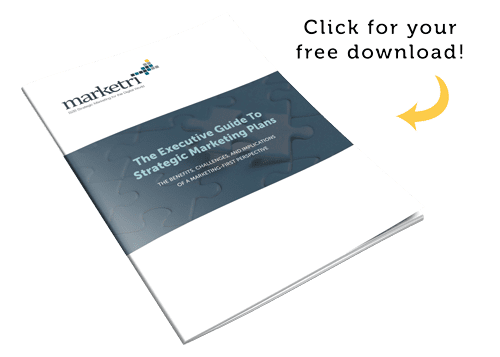7 Actionable Ways to Prepare Your Marketing Strategy for the Future
As marketing transforms at breakneck speed, the threat that changing buyer behaviors and trends put on companies is no longer hypothetical. Organizations are working to secure their market share and revenue from increasingly major disruptors, technological advances, and globalization.
More and more companies are jumping down the rabbit hole of buyer dynamics, and broadening their strategic vision to compete in a fast and complex environment. However, creating a cohesive marketing strategy when responsibility is spread across the entire firm is challenging.
These plays will help you brace for the future and even flourish in it.

1. Own Your First-Party Data
First-party data is the information you collect from your audience. Surveys, feedback, behavioral actions taken on your website, the information in your CRM — these are all examples of first-party data. It’s considered to be the most valuable because it’s easy to collect, store, and use.
Firms use first-party data in three key ways: to predict future patterns about audience behavior (especially when it directly affects advertising and marketing tactics); to gain, measure, and model audience insights; and to help personalize content and adjust strategy accordingly.
For a marketing strategy to be successful, you need to own your first-party data. A common mistake that marketing leaders make is outsourcing to third-party vendors to collect and manage it. The reality is, for your entire marketing strategy to run more efficiently, your data practices need to be transparent and secure. It’s the difference between doing things right and losing your clients’ trust.
2. Map Out What Will Help Clients Win at Each Touchpoint
First, companies must get a clear picture of their buyer’s journey. Since different clients (and services) require different approaches, you should determine the online and physical experiences of both new buyers and churned ones. That may mean hiring for roles like Chief Growth Officer or Strategist who can interview your client base, create a roadmap, and put it to work.
A framework for mapping buyer journeys is beyond the scope of this article. But here is a standardized approach for helping them win during the buying process:
- Create content that helps potential and existing buyers.
- Answer every question they have before purchase.
- Remove friction from the buying experience. Offer free consultations or low-commitment, high-impact services.
- Shorten time to value once a new client starts using your product or service.
- Make support proactive and respond quicker.
The key is to focus on the outcomes you want to see. Many companies are behind in fully understanding the experience their buyers have. Getting inside their minds can help you adapt to their changing behaviors and sustain competitive advantage.
3. Invest in High-Growth Future Markets
A good B2B marketing plan requires a hard look at market segment dynamics. They are usually mature and quickly growing markets you already exist in. By keeping a close eye on them, you can easily identify areas for potential expansion. This allows you to build expertise or shape products for high-growth markets. Plus, supports your firm in taking the necessary steps to stay well-positioned.

Here’s an example from our strategic marketing consultant team:
When we work with clients, we typically assess their vertical markets using the Boston Consulting Group’s Growth Matrix.
- What markets are well penetrated and mature that can provide steady revenue today?
- What are high growth markets have our clients developed awareness. Should they double down?
- What high growth markets should be at least considered due to their attractive dynamics even though expertise and awareness is low.
- What markets have unattractive dynamics and low market recognition? No marketing resources should be channeled here.
In terms of market dynamics, you typically look for a high projected growth rate, an attractive pool of B2B companies (low level of consolidation), and company expertise and qualifications within that market.
4. Turn Your Blog Into a Library of Resources
Every department in your organization should have a way to share content ideas. It can give you ongoing insight into client issues, and help you create content that makes an impact on your buyers’ journey.
Content can take many forms: social media posts, blogs, videos, regulatory change reports, free courses and trainings. Types of content may be all over the map, but one thing is sure, in time, it will hand you warm leads on a silver platter ready for the sale.
To put this in perspective, you want to turn your blog into a library of resources versus a publication. Publication content is short-lived. It’s rooted in velocity, and engagement dies off after a few weeks. Resourceful, evergreen content lives on your blog forever. It typically ranks higher in search engines and can weather any trends because it’s always helpful.
Remember, more content does not always equal better results. The resource approach is not only less time-consuming, but a more effective and affordable way to drive revenue through content marketing.
5. Optimize Channel Allocation
Choosing your channels isn’t a set-it and forget-it practice. It’s a good idea to revisit your channels and adjust spend regularly. You should look to:
- Analyze if new channels are a fit for your firm. Are your clients regular Facebook Messenger users? If yes, test it and see what results come through.
- Decide total percent of lead generation a channel is responsible for. If a channel is underperforming, revisit your strategy or cut it out completely.
- Look for what channels deliver the best quality leads. Is organic search only driving traffic, but not MQL’s?
A good marketing strategy should be centered around meaningful conversations that move potential clients further down the funnel. Done well, spending more on effective channels can help you get more qualified leads.
6. Automate Select Processes
As your firm scales, your workflows will become more complex. Let’s look at how firms factor automation into their decisions about long-term marketing strategy.
- Proactive communication. Marketing automation can keep audiences informed and help companies build trust with potential (and existing) clients. For example, say you’re a private equity firm, if a change in regulatory environment is about to happen, you can update clients on how it’ll impact their investment. Using a chatbot or email automation program, you can reach thousands of people at once with a personal touch.
- Lead nurturing. Managing diversified acquisition channels is hard. Projects require long-term planning, resourcing, and budgeting. Firms can lessen the burden by automating distribution. Automation programs enable you to segment your audience and send information to individuals based on interest. *For example, when a lead comes in any traffic source, you can capture their info, domain knowledge, interest level, and then educate them until they are ready to buy— all on autopilot
- Client self-service and on-boarding. Many companies don’t yet enable self-service. Some may have live chat or email support and don’t expect it to have an impact on their cash flow. This is a false assumption. More than half (53%) of buyers think it is important for them to resolve their own product/service problems rather than rely on support teams. Companies that offer self-service save between $1 – 3 million in support costs, according to Accenture. FAQ’s, knowledge bases, or online communities are all examples of this type of buyer support.
Only firms that understand and proactively manage automation will sustain long-term advantage as more and more buyers flock to instant communication.
7. Create Long-term Partnerships.
It’s tempting to fixate only on acquiring more and more leads, but this less stable for long-term growth. Companies forget that their clients have plenty of other options. They could move everything in-house, use freelancers, or switch to another agency.
Many high-growth industries go pedal to the medal to see a quick return on investment, and they overlook the fact that strong partnerships are the backbone of sustainable business growth. It’s growth that can weather any changes in technology, trends, and buyer behavior.
To secure long-term partnerships, become the firm that helps clients:
- Determine the right goals for their business.
- Create the overall plan.
- Analyze and iterate on over performance.
Even partnerships with smaller companies can be lucrative if they expose you to new markets. Say you want to increase market share in a competitive B2B niche, a smaller partner can have more influence over its immediate network. Those smaller, but more targeted followings could represent tens of thousands of dollars in revenue.

What Marketing Strategy Will You Bring to Your Business Next Year?
Firms both large and small feel the impact of changing behaviors and trends in business. Your marketing strategy should be designed to make it easier to adapt and thrive in your industry.
By using the actionable plays in this article, you can delight your clients and show better ROI — a win-win situation. All you need is enthusiasm and flexibility to evolve your strategy and continually reap the rewards.
Ready to Start?
For more information on developing a strong strategic marketing plan for your consumers, download our guide by clicking the image below:






